The Chromebook Pixel (2015) Review
by Brandon Chester on March 16, 2015 8:00 AM EST- Posted in
- Laptops
- Chrome OS
- Chromebook
- Chromebook Pixel
Display
When the original Chromebook Pixel launched two years ago, its big selling point and the source of its name was its 239ppi 2560x1700 display. At that time, the only other laptops on the market with HiDPI displays were Apple's Retina MacBook Pros. Chromebooks have typically aimed for the low-cost segment of the laptop market, and so it was quite a surprise that one of the earliest HiDPI laptops was a Chromebook. Although the Pixel had the highest pixel density of any laptop display at the time, it fell somewhat short when it came to color reproduction due to its narrow color gamut and lack of calibration. With the new Chromebook Pixel, Google has advertised coverage of the sRGB color gamut, along with a maximum brightness of 400nits.
To see whether or not Google has hit their mark, we turn to our standard display testing workflow. As usual, all measurements are performed using SpectraCal's CalMAN 5 software along with X-Rite's i1Pro 2 spectrophotometer, with the exception of black level measurements which are performed with an i1Display Pro colorimeter.
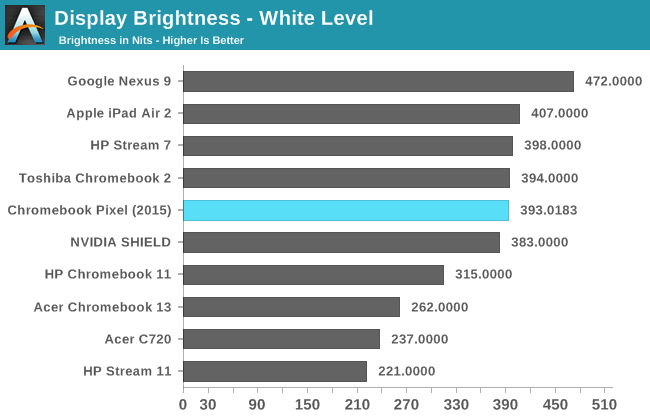
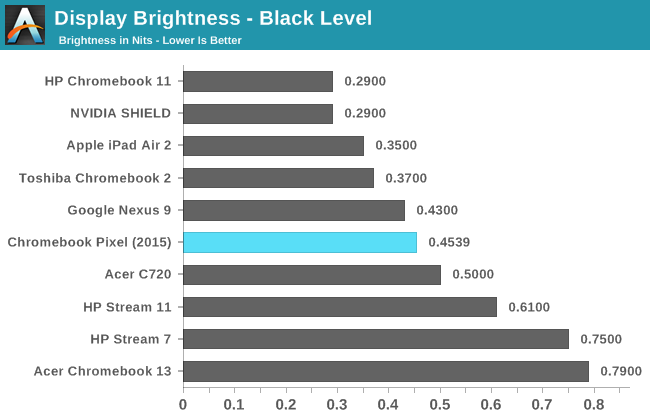
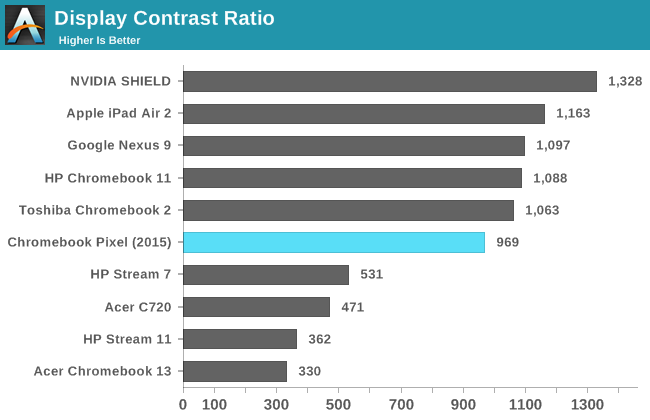
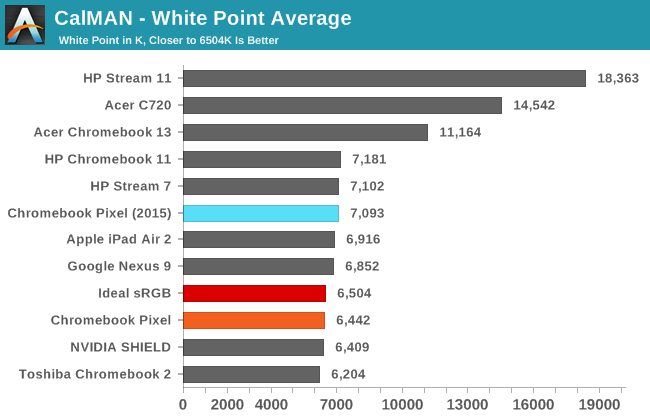
Due to the evolution of our display workflow as time has gone on, I don't have results to compare the new Pixel to the original for certain categories. The result for maximum brightness is certainly in line with Google's advertised 400nit brightness, while the black levels and contrast ratio are what you would expect of IPS panels. The white point is noticeably more blue than the ideal D6504 target, which contrasts with the original Pixel which was very slightly too red. The blue/green tint in white and shades of grey is also more obvious than most other devices with similar average white points, which I elaborate on further below.

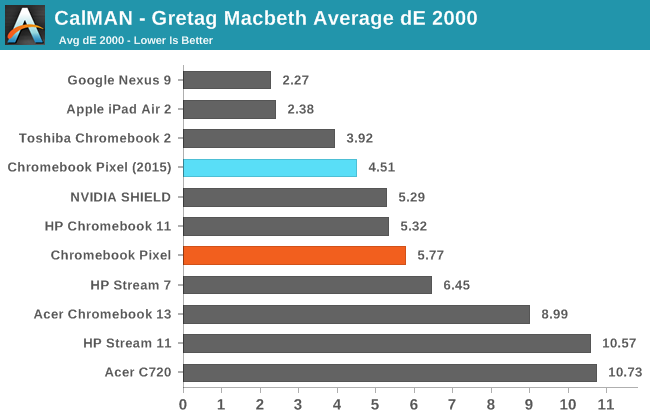
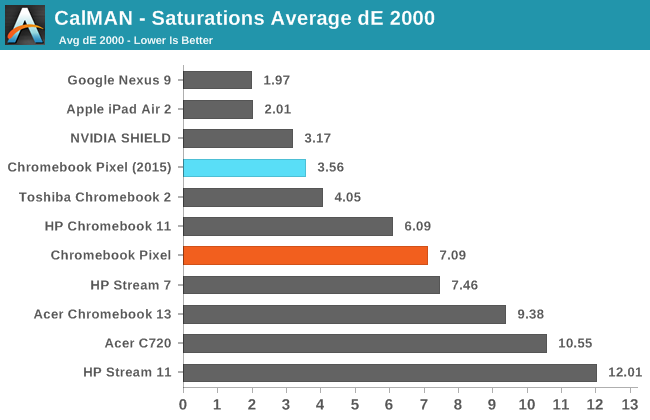
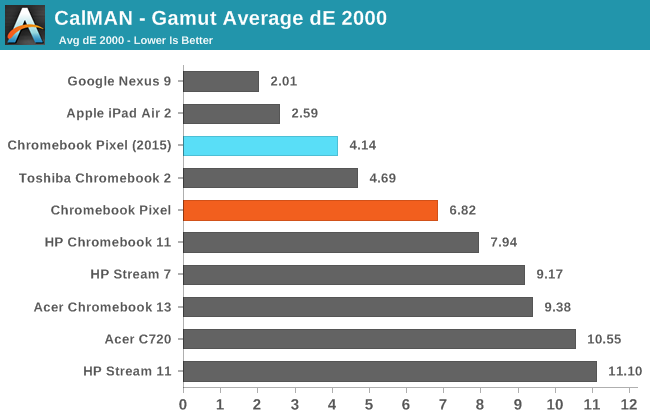
The new Pixel improves significantly upon the original in the gamut and saturation tests. It has a much wider gamut than the original, although it misses in magenta and yellow. Saturation improvements follow the improved gamut, as colors of 80% and 100% saturation no longer look identical. Despite these improvements, there hasn't been much progress on greyscale and color mixture accuracy. As noted earlier, the Pixel has a fairly obvious green/blue tint to the lighter shades of grey and white. As you can see in the gallery below, this is due to the reduction in red and increase in blue components of luminance as the shades of grey move from black to white.
I don't expect that many Chromebook users will be doing heavy photo and video editing that requires a perfectly calibrated display. Many $999 laptops ship with displays that are much worse than the one on the new Pixel, and I think that most users will be very happy with the Pixel's display. It's just a shame that Google doesn't seem to have put the same amount of care into display calibration with the Pixel as they have with the Nexus 9 and other Google branded devices, despite it having the highest price point of the devices they sell.
















123 Comments
View All Comments
jimbo2779 - Tuesday, March 17, 2015 - link
You cannot ski 24/7, also kids tend to enjoy watching things they like while their parents sit around and have a relaxing drink.Face it 32GB is a tiny amount, especially when you are splashing this much cash for a laptop, it is absolutely inexcusable. There are so many scenarios where you would want some media on the machine and you would easily fill this up. Having to lug around extra USB drives to ensure you have enough storage when away from a net connection is just not as convenient.
Relying on cloud or NAS for your media is fine if you never leave your home or office but when you are out and about you need LTE for full coverage and not only does this cost more you are not always covered when not in a city and coverage can be spotty when you do have it.
On top of this there is the argument of relying on cloud storage which is great until they start charging for it after a few years so something that could have been added in the high price of your laptop is now costing real money.
Again, 32Gb at this price point is inexcusable, there are many reasons as to why.
armwood - Sunday, September 20, 2015 - link
It seems that so many people do not understand the concept of the Chrome operating system. It is a cloud system. Wifi is most places and where it is not either carry a hotspot or tether your phone. It is not rocket science. Google Drive or Dropbox can whole all of your data with movies etc on an SD card. Wake up, this is the future of computing. It amazes me how shortsighted so many people are.armwood - Sunday, September 20, 2015 - link
You need to spend a fee days with a Chromebook Pixel 2 LS. I use it and leave my Macbook Pro and Surface Pro 3 on my desk. I take it and use it for my college lectures over the other two machines. It is a superb, fast device that works in environments with weaker wifi signals better than Apple or Windows computers.jabber - Wednesday, March 18, 2015 - link
I've been using my Chrombook for over 2 years now. No user data has ever touched the 16GB SSD in it in all that time.I don't get the love for 'big data'. Just seems like tying yourself down to a huge anchor.
armwood - Sunday, September 20, 2015 - link
It seems that so many people do not understand the concept of the Chrome operating system. It is a cloud system. Wifi is most places and where it is not either carry a hotspot or tether your phone. It is not rocket science. Google Drive or Dropbox can whole all of your data with movies etc on an SD card. Wake up, this is the future of computing. It amazes me how shortsighted so many people are.psychobriggsy - Monday, March 16, 2015 - link
There's a lot to like about this product - especially the hardware and design.If it came with a 256GB SSD with Crouton pre-installed, that would have been great. 32/64GB isn't enough so you'd need to spend more on replacing this - a build option would be great. Yeah, I know this doesn't fit into Google's concept of a computing device.
The touchscreen is a bit pointless, unless they had made the device more Yoga-like, with a tablet folding mode.
In terms of hardware design, this is up there with the best. Other OEMs can learn a lot from this, for their non-Air-ripoff designs.
Hanoveur - Monday, March 16, 2015 - link
You can buy a 256gb XDSC card and plug that into it.jimbo2779 - Tuesday, March 17, 2015 - link
And spend more money fixing something that should not be an issue, sounds like a great solution.Also it is easy to lose a memory card, especially when kids are around. Built in storage is slightly harder to lose
steven75 - Wednesday, March 18, 2015 - link
Did you just bring up Flash player in 2015?djw39 - Monday, March 16, 2015 - link
But that "real computer" can be old and cheap. For example, I have a desktop PC I got 10 years ago for $500, anything the chromebook can't do due to limitations of the OS can theoretically be done on the desktop. In real life I almost never use the desktop.Now, I fully admit, I'd take an orange-and-white plastic version for $500-600. But I think a high-resolution screen and Core i5 sounds about right for the hardware.